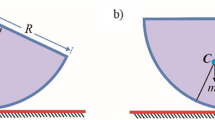Conclusions and recommendations
Thus, the use of perturbation theory allows an economical, searchless, computation procedure to be constructed for the problem of parametric identification. The method may be extended to the case of a multidimensional model with nonlinear and nonsteady operators.
At high noise levels of the experimental signal, a functional that is more conservative with respect to noise is preferable, in the form\(J_j = \int\limits_0^{^\tau j} {y^e (\tau ) d\tau } \), for which perturbation theory is constructed analogously, under the condition Pj=1. Here also, ze and ye may be taken in the form of the results of statistical measurements Rzz and Rzy, i.e., the self- and mutual correlations of the noise functions of these signals, respectively.
The perturbation formulas in Eqs. (6) and (9) are useful for the engineering diagnostics of NPP elements performed on the basis of an analysis of slow variations over time in the parametersa ′i . In this case, identification by the given algorithm must be repeated periodically in the course of NPP running tests or use.
Similar content being viewed by others
Literature Cited
L. N. Usachev, in: Reactor Construction and Reactor Theory [in Russian], Izd. Akad. Nauk SSSR, Moscow (1955), p. 251.
J. Lewins, Value. Conjugate Functions [Russian translation], Atomizdat, Moscow (1972).
A. N. Tikhonov and V. Ya. Arsenin, Methods of Solving Incorrect Problems [in Russian], Nauka, Moscow (1974).
A. M. Tsirlin, V. S. Balakirev, and E. G. Dudnikov, Variational Methods of Optimizing Controllable Objects [in Russian], Énergiya, Moscow (1976).
G. I. Marchuk, Methods of Numerical Mathematics, Springer-Verlag (1975).
V. Ya. Pupko, Preprint FÉI-176, Obninsk (1969).
D. Hudson, Statistics for Physicists [Russian translation], Mir, Moscow (1970).
L. Rabiner and B. Gould, Theory and Application of Digital Signal Processing, I.E.E.E., London (1973).
E. Kamke, Handbook on Ordinary Differential Equations [in German], Chelsea Publ. (1974).
Technical Problem of Fast-Neutron Reactors [in Russian], Atomizdat, Moscow (1969).
V. Ya. Pupko, Inzh.-Fiz. Zh.,11, No. 2, 242 (1966).
Additional information
Translated from Atomnaya Énergiya, Vol. 48, No. 4, pp. 238–242, April, 1980.
Rights and permissions
About this article
Cite this article
Pupko, V.Y., Zrodnikov, A.V. Use of perturbation theory in investigating the engineering and physical characteristics of nuclear power plants. At Energy 48, 239–244 (1980). https://doi.org/10.1007/BF01146656
Received:
Issue Date:
DOI: https://doi.org/10.1007/BF01146656




